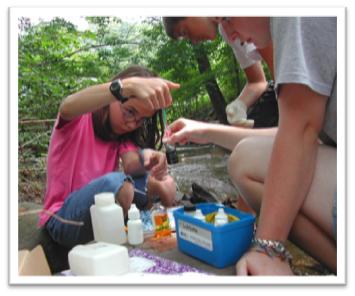 A creek can carry an amazing amount of chemicals. (One reason is that any activity on the land that surrounds the
creek can usually affect the creek.) Some of these chemicals are so abundant that they mask "or hide" what is actually
going on in the creek. For example, an abundant amount of minerals, metals, and sulfates may increase the pH of the creek, but
when these substances drop out of the water, such as when the water flows over rocks or through wetlands, the chemistry of the creek
changes and the pH may actually decrease.
A creek can carry an amazing amount of chemicals. (One reason is that any activity on the land that surrounds the
creek can usually affect the creek.) Some of these chemicals are so abundant that they mask "or hide" what is actually
going on in the creek. For example, an abundant amount of minerals, metals, and sulfates may increase the pH of the creek, but
when these substances drop out of the water, such as when the water flows over rocks or through wetlands, the chemistry of the creek
changes and the pH may actually decrease.
Tools and things you will need
- Access to a refrigerator
- Access to a stove
- Gloves
- Hydrogen peroxide
- Litmus paper
- Small jars (i.e. baby food jars, pill jars etc.)
- Rubber boots
What to do?
Note: Write down your results each time you check the pH.
- Fill a small jar or pill bottle to the top with water from your creek.
- Test the waters pH with litmus paper.
- Pour in one capful of peroxide.
- Let the red flocculates settle.
- Test the water again for its pH.
- Repeat the experiment with water placed in a refrigerator for one hour.
- Repeat the experiment with water left in a warm stove for one hour.
- Repeat the entire experiment using baking soda.
What did you see?
- What happened when you put hydrogen peroxide in the water? What about baking soda?
- What happened to the pH?
- Which reaction (refrigerator or warm stove) occurred faster?
- What else did you see?
What do you conclude?
- What kind of chemical reaction did you perform?
- Does heat or cold speed up a reaction?
- What are your conclusions? "Write down what you think."
[
Learn more...]